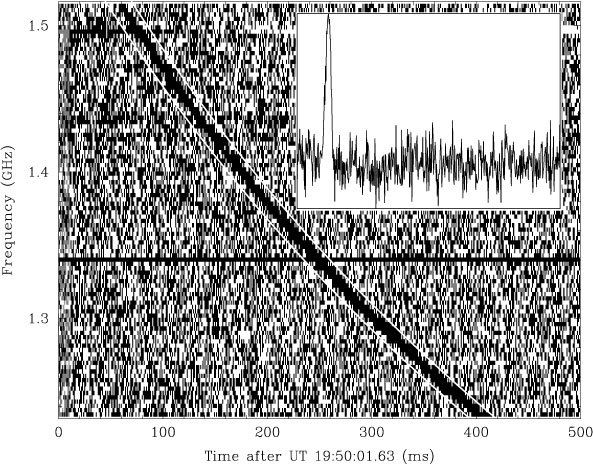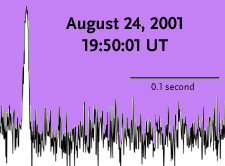
Full details and parameters for all currently known FRBs can be found in the HeRTA FRB Catalogue.
FRB 010724 (the Lorimer Burst)
F&M was involved in the discovery and analysis of the first of these bursts reported, FRB 010724 (the Lorimer Burst), which was found in a Parkes survey of the Small Magellanic Cloud. For scientific details about FRB 010724, please consult "A Bright Millisecond Radio Burst of Extragalactic Origin" by D. R. Lorimer et al., Science, 318, 777 (2007).
For a layman's explanation, you can read the media report of the discovery in Strong Extragalactic Radio Burst Poses a Mystery at NPR's All Things Considered web site (the radio broadcast of the report is also there, and you can listen to that).
Three of our team members on this discovery (Bailes, Lorimer, and McLaughlin) were also honored with the 2023 Shaw Prize in Astronomy.
FRB 121102 (aka "The Repeater")
F&M was also part of the discovery (and redetection) team for FRB 121102, the only FRB discovered to date with the Arecibo telescope and the only one observed so far to repeat its burst emission. For details about FRB 121102, see "Fast Radio Burst Discovered in the Arecibo Pulsar ALFA Survey" by L. G. Spitler et al., Astrophysical Journal, 790, 101 (2014)
The first followup detection of multiple bursts from the same source was published in "A Repeating Fast Radio Burst" by L. G. Spitler et al., Nature, 531, 202 (2016). On the Nature page there is also a nice audio interview with several researchers about this finding and other recent FRB science.
You can read news coverage of this redetection in several media outlets, including National Geographic, Scientific American, The Washington Post, USA Today, Sky and Telescope, Popular Science, The Christian Science Monitor, and Franklin and Marshall College News.
Later localization of this burst source using VLA follow-up observations was reported in "A Direct Localization of a Fast Radio Burst and Its Host" by S. Chatterjee et al., Nature, 541, 58 (2017).
Single pulse plots from some of the VLA phased-beam follow-up observations of the Arecibo FRB field are here:
Four FRBs from the Parkes 70-cm Survey Re-Analysis
We found four new FRBs in a reprocesing of the Parkes 70-cm Survey for pulsars. The new FRBs have several distinguishing features.
More details can be found in "Four New Fast Radio Bursts Discovered in the Parkes 70-cm Pulsar Survey Archive" by F. Crawford et al., Monthly Notices of the Royal Astronomical Society, 515, 3698 (2022). Several F&M students were co-authors on this paper.
See also the Parkes 70cm Survey page at F&M.
Plots and Figures
Below: A plot of the arrival of the (dispersed) Lorimer burst, with frequency vs. time shown (inset is the burst after dedispersion):

Below: The Lorimer burst after dedispersion and channel summing has
been applied, shown as a function of time (see also the inset of the
previous image):

Below: Image of the SMC with the location of the Lorimer burst
indicated (note that we also have a larger
image with a white background):

Below: A plot of Arecibo burst FRB 121102. The burst arrival is shown
with frequency vs. time plotted (the inset is a plot of the burst
after dedispersion).
